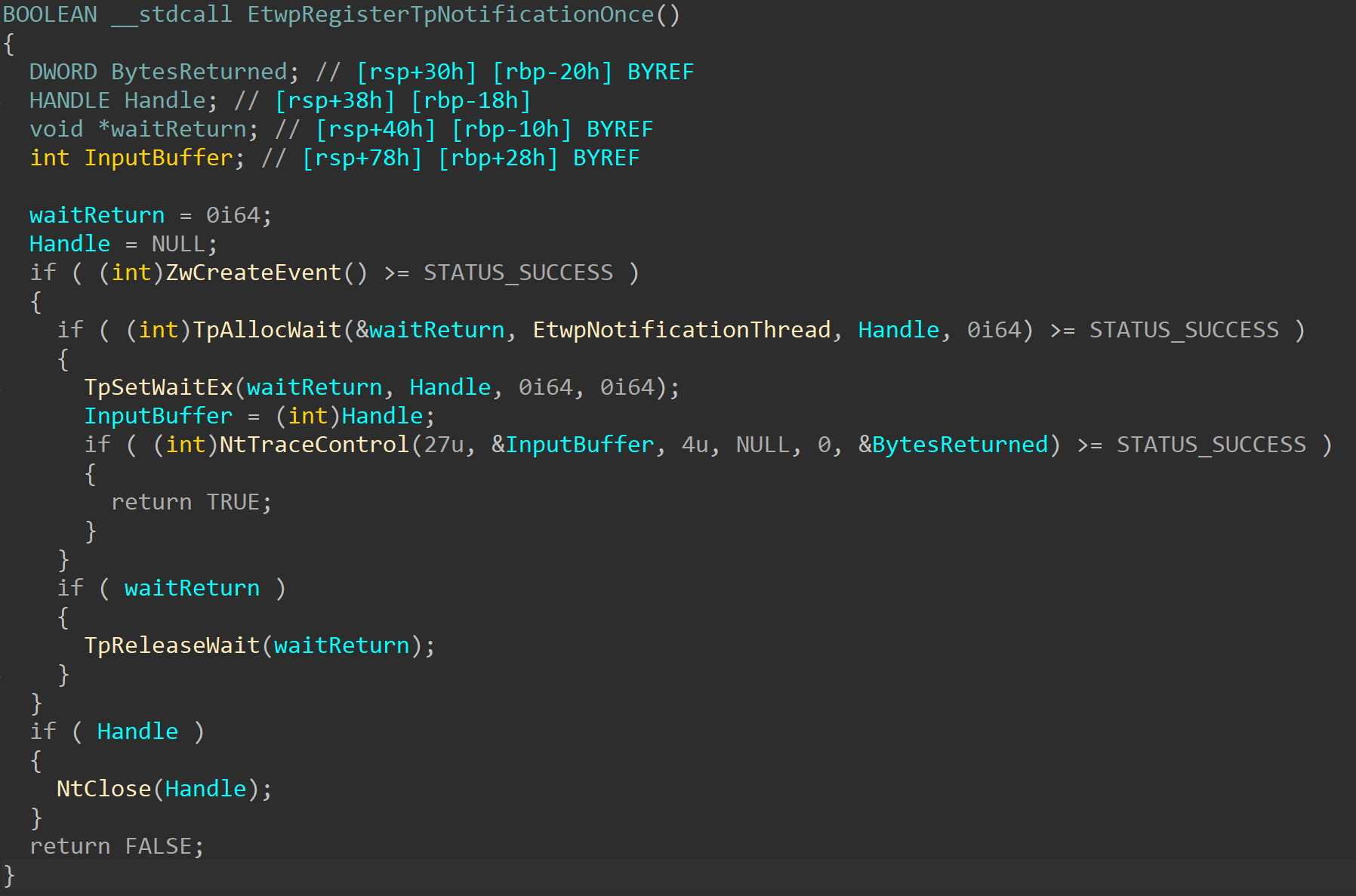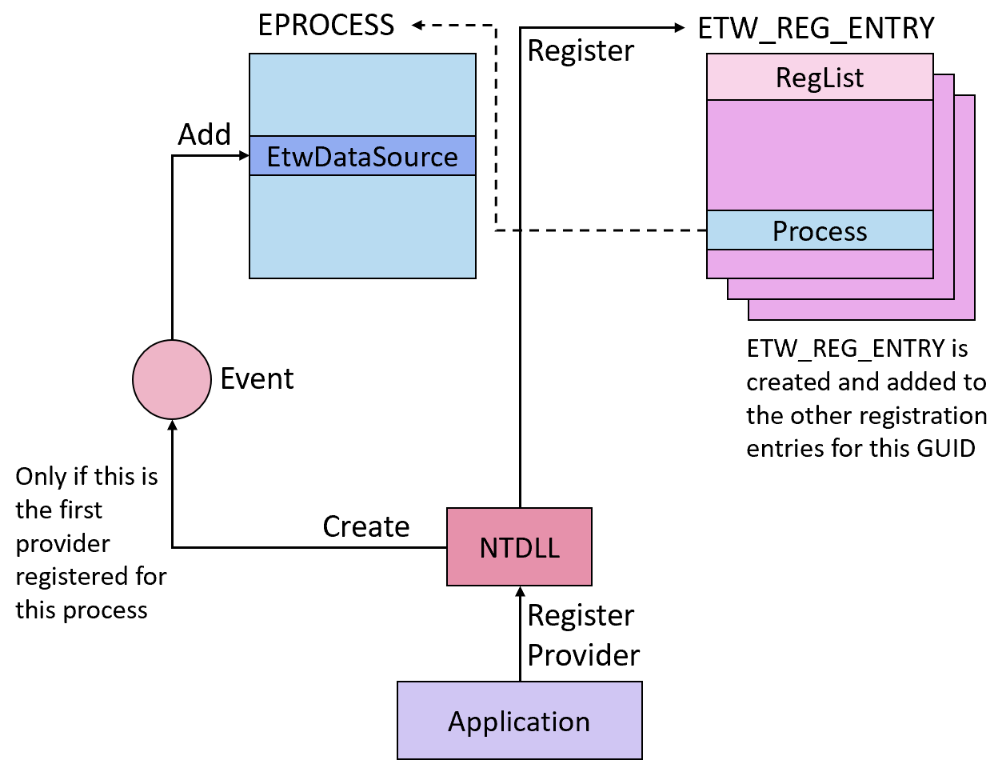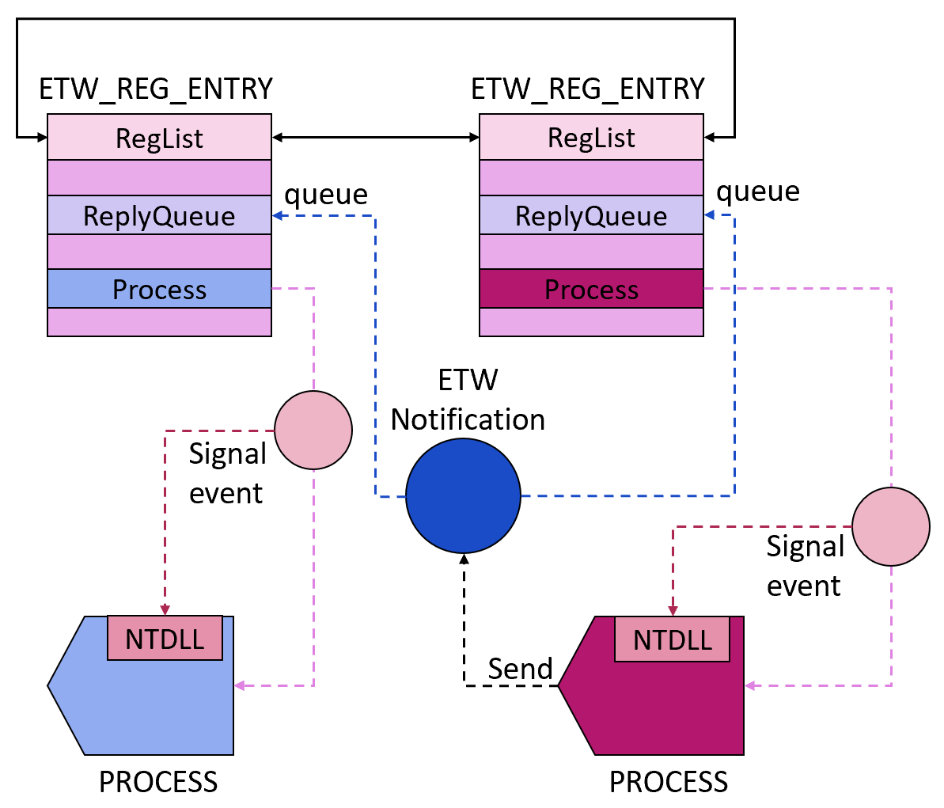Introduction
This post is not actually directly related to the first one and does not use CVE-2020-1034. It just talks about a second vulnerability that I found while researching ETW internals, which discloses the approximate location of the NonPaged pool to (almost) any user. It was spurred by a tweet that challenged me to find an information leak. It turns out I found one that wasn’t actually patched after all!
The vulnerability itself is not especially interesting, but the process of finding and understanding it was fun so I wanted to write about that. Also, when I reported it Microsoft marked it as “Important” but would not pay anything for it and eventually marked it as “won’t fix” even though fixing this issue takes less time than writing an email, so the annoyance factor alone makes writing this post worth it. And this is a chance to rant about some more ETW internals stuff which didn’t really fit into any of the other posts, so you can read them or skip right to the PoC, your choice.
Update
This vulnerability was eventually acknowledged by Microsoft and received CVE-2021-24107. It was fixed on 9/3/2021.
More ETW Internals!
Remember that the first thing you learn about ETW notifications are that they are asynchronous? Well, that was a lie. Sort of. Most ETW notifications really are asynchronous. However, in the previous blog post we used a vulnerability that relied on improper handling of the ReplyRequested field in the ETWP_NOTIFICATION_HEADER structure. The existence of this field implies that you can reply to an ETW event. But no one ever told you that you can reply to an ETW notification, how would that even work?
Normally, ETW works just the way you were told. That is the case for all Windows providers, and any other ETW provider I could find. But there is a “secret setting” that happens when someone notifies an ETW provider with ReplyRequested = 1. Then, as we saw in the previous blog post, the notification gets added to a reply queue and is waiting for a reply. Remember, there can only be 4 queues notifications waiting for a reply at any moment. When that happens, any process which registered for that provider has its registered callback notified and has a chance to reply to the notification using EtwReplyNotification. When someone replies to the notification, the original notification gets removed from the queue and the reply notification gets added to the reply queue.
The only case I could see so far where a reply is sent to a notification is immediately after a GUID is enabled – sechost!EnableTraceEx2 (which is the standard way of registering a provider and enabling a trace) has a call to ntdll!EtwSendNotification with EnableNotificationPacket->DataBlockHeader.ReplyRequested set to 1. That creates an EtwRegistration object, so before returning to Sechost, Ntdll immediately replies to the notification with NotificationHeader->NotificationType set to EtwNotificationTypeNoReply, simply to get it removed from the notification queue.
Specifically, in this case, something a little more complicated happens. Even though Ntdll is enabling the GUID, it’s not the “owner” of the registration instance and therefore doesn’t have a registered callback (since this belongs to whoever registered the provider). Yet Ntdll still needs to know when the kernel enables the provider, to queue the reply notification – it can’t expect the caller to know that this needs to be done. So to do this, it uses a trick.
When EtwRegisterProvider is called, it calls EtwpRegisterProvider. The first time this function is called, it calls EtwpRegisterTpNotificationOnce:
Without getting into too many internal details about waits and the thread pool, this function essentially creates an event with the callback function EtwpNotificationThread and then calls NtTraceControl with an Operation value of 27 – an undocumented and unknown value. Looking at the kernel side of things, it’s not too hard to give this value a name:
I’ll call this operation EtwAddNotificationEvent.
EtwpAddNotificationEvent is a pretty simple function: it receives an event handle, grabs the event object, and sets EventDataSource->NotificationEvent in the EPROCESS of the current process to the event (or NotificationEventWow64, if this is a WoW64 process). Since this field is a pointer and not a list, it can only contain one event at a time. If this field is not set to 0, the value won’t be set and the caller will receive STATUS_ALREADY_REGISTERED as a response status.
Then, in EtwpQueueNotification, immediately after a notification is added to the notification queue for the process, this event is signaled:
The event being signaled makes the EtwpNotificationCallback get called, since it was registered to wait on this event, so it is, in a way, an ETW notification callback that is being notified whenever the process receives an ETW notification. However, this function is not a real ETW notification callback, so it doesn’t receive the notification as any of its parameters and has to somehow get it by itself in order to reply to it. Luckily, it has a way to do that.
The first thing that EtwpNotificationThread does is make another call to NtTraceEvent, this time with operation number 16 – EtwReceiveNotification. This operation leads to a call to EtwpReceiveNotification, which chooses the first queued notification for the process (and matching the process’ WoW64 status) and returns it. This operation requires no input arguments – it simply returns the first queued notification. This gives EtwpNotificationThread all the information that it needs to reply to that last queued notification quietly, without disturbing the unaware caller that simply asked it to register a provider. After replying, the event is set to a waiting state again, to wait for the next notification to arrive.
Most of this pretty long explanation has nothing to do with this vulnerability, which really is pretty small and simple and can be explained in a much less complicated way. But I did say this post was mostly an excuse to dump some more obscure ETW knowledge in hope that one day someone other than me will read it and find it helpful, so you all knew what you were getting into.
And now that we have all this unnecessary background, we can look at the vulnerability itself.
The InfoLeak
The issue is actually in the last part we talked about – returning the last queued notification. If you remember from the last post, when a GUID is notified and the notification header has ReplyRequested == 1, this leads to the creation of a kernel object which will be placed in the ReplyObject field of the notification that is later put in the notification queue. And this is the same structure that can be retrieved using NtTraceControl with EtwReceiveNotification operation… Does that mean that we get a free kernel pointer by calling NtTraceControl with the right arguments?
Not exactly. To be precise, you get half of a kernel pointer. Microsoft didn’t completely ignore the fact that retuning kernel pointers to user-mode callers is a bad idea, like they did in so many other cases. The ReplyObject field in ETWP_NOTIFICATION_HEADER is in a union with ReplyHandle and RegIndex. And after copying the data to the user-mode buffer, they set the value of RegIndex, which should overwrite the kernel pointer that is in the same union:
The only thing that this code doesn’t account for is the fact that ReplyObject and RegIndex don’t have the same type: ReplyObejct is a pointer (8 bytes on x64) while RegIndex is a ULONG (4 bytes on x64). So setting RegIndex only removes the bottom half of the pointer, leaving the top half to be returned to the caller:
Triggering this is extremely simple and includes exactly three steps:
- Register a provider
- Queue a notification where
ReplyObjectis a kernel object – do this by callingNtTraceControlwithoperation == EtwSendDataBlockandReplyRequested == TRUEin the notification header. - Call
NtTraceControlwithoperation == EtwReceiveNotificationand get your half of a kernel pointer.
It’s true that the top half of a kernel address is not all that much, but it can still give a caller a better guess of where the NonPagedPool (where those objects are allocated) is found. In fact, since the NonPagedPool is sized 16TB (or 0x100000000000 bytes), this vulnerability tells us exactly where the NonPaged pool is, and we can validate that in the debugger:
!vm 21
...
System Region Base Address NumberOfBytes
SecureNonPagedPool : ffff838000000000 8000000000
KernelShadowStacks : ffff888000000000 8000000000
PagedPool : ffff8a0000000000 100000000000
NonPagedPool : ffff9d0000000000 100000000000
SystemCache : ffffb00000000000 100000000000
SystemPtes : ffffc40000000000 100000000000
UltraZero : ffffd40000000000 100000000000
Session : ffffe40000000000 8000000000
PfnDatabase : ffffe78000000000 c8000000000
PageTables : fffff40000000000 8000000000
SystemImages : fffff80000000000 8000000000
Cfg : fffffaf0ea2331d0 28000000000
HyperSpace : fffffd0000000000 10000000000
KernelStacks : fffffe0000000000 10000000000
This can be triggered from almost any user, including Low IL and AppContainer, where most of the classic infoleaks don’t work anymore, this might be of some use, even if a limited one.
I believe that when this code was introduced, it was completely safe – those areas of the code are pretty ancient and get very few changes. This code was probably introduced in the days before x64, when the size of a pointer and the size of a ULONG was the same, so setting RegIndex did overwrite the whole object address. When x64 changed the size of a pointer, this code was left behind and was never updated to match this, so this bug appeared.
This makes you wonder what similar bugs might exist in other pieces of ancient code that even Microsoft forgot about?
Just Show Me the Code Already!
In case you want to see the three lines of code that trigger this bug, you can find them here.







Leave a comment